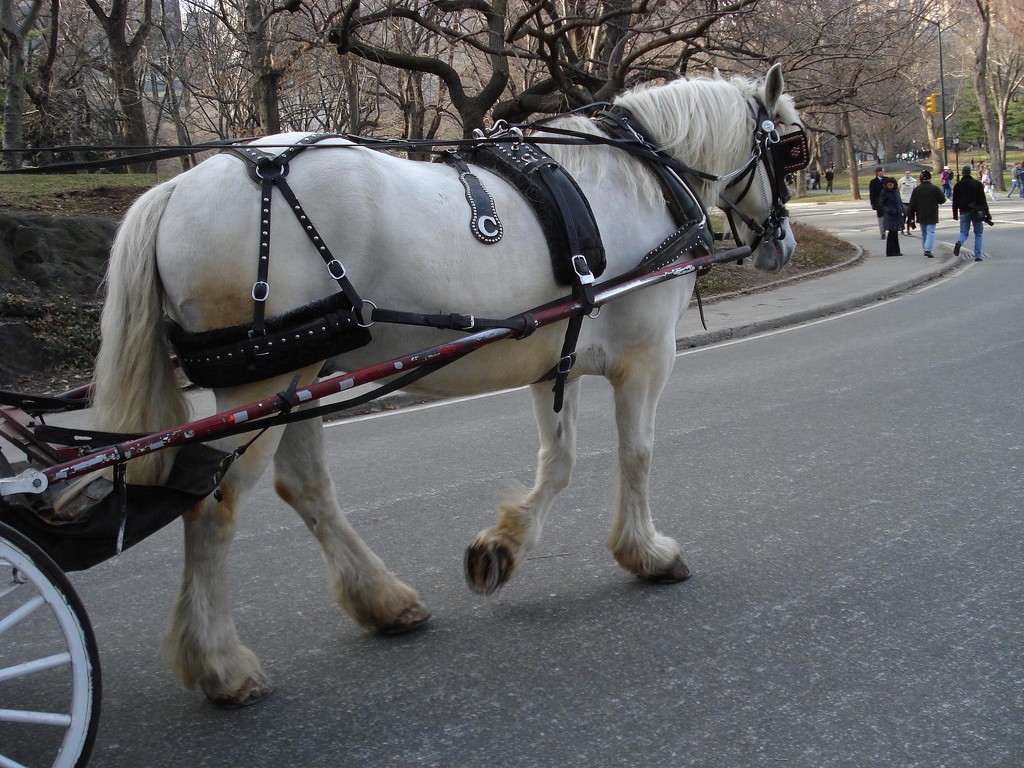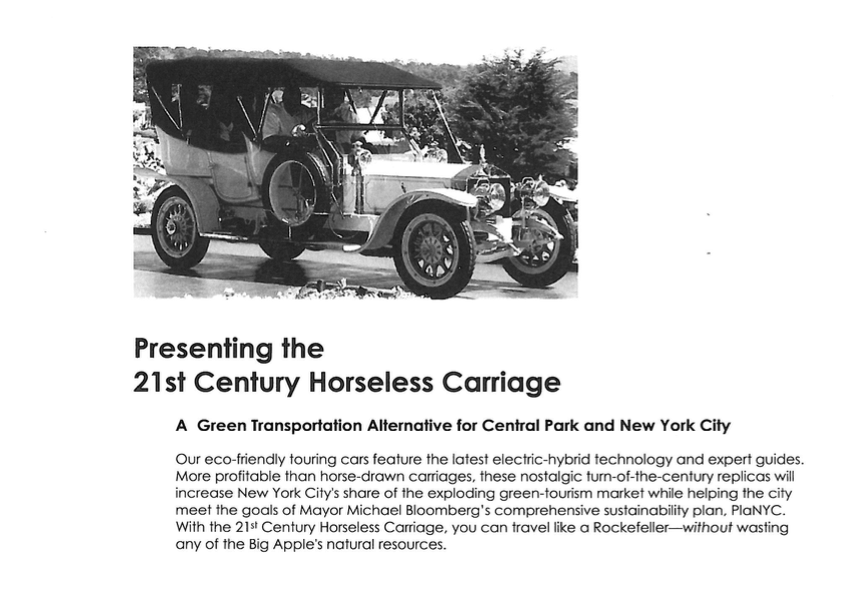All the Mayor's Horses
by Brendan O’Connor

One of the less explicable things the affably inept Bill de Blasio promised voters during his mayoral campaign was to ban the horse-drawn carriage industry in New York City — in his first week in office. “This is an utter embarrassment,” Councilman Ritchie Torres, a Bronx Democrat, said in response to draft legislation introduced in 2014. “I have so many more important priorities in my district and this is not one of them, so I can’t believe we are spending time on this.” On Sunday, in the middle of a holiday weekend, the mayor announced a deal that would resolve the city’s most absurd and acrimonious dispute of the past two years, if it’s approved by the City Council.
The deal would not ban the horse-drawn carriage industry outright, but would shrink it significantly, reducing the total number of carriage horses permitted to operate in the city to seventy-five, down from two hundred and twenty. Moreover, the horses would move from their current stables, on Manhattan’s increasingly valuable West Side, to a city-owned building in Central Park, near the 86th Street Transverse, which would be renovated to accommodate its new tenants. The Parks Department, Politico New York reports, has for decades used the building (“the shop”) as a maintenance facility.
New York City, 19 January 2016. 🐎🐎🐎 pic.twitter.com/ogqElQUw6V
— Josh Robin (@joshrobin) January 19, 2016
Initially, New Yorkers for Clean, Livable and Safe Streets (NYCLASS), the animal-rights group leading the effort to ban the industry, came out against the proposal. “The legislation doesn’t go far enough to protect the horses from working in extreme temperatures, and doesn’t protect horses from working into old age of twenty-six,” the group said in a statement on Wednesday. “We will settle for nothing less for the horses.” On Thursday, after reviewing the agreement further, NYCLASS appeared to change course. “After careful consideration of the legislation, we support its passage to help protect the carriage horses from traffic and cruelty,” the group said. “The Mayor and the Speaker have stood up for horses and we are ready to stand with them.” Back in 2007, though, when he was still a councilman, the New York Post reports that de Blasio passed on the opportunity to stand up for horses when similar legislation came through the City Council.
Campaign finance records show that, in 2010 and 2011, de Blasio received $5,500 from Steve Nislick, who is the co-founder and president of NYCLASS. (Reached by phone on Thursday, a receptionist at Nislick’s office asked me to wait while she checked to see if he was in his office. Without covering the receiver or putting me on hold, she could be heard asking if he would take a call from “Brendan Connor, from the Awe. A-W-E.” She told me he was not in his office.) Wendy Neu, who owns the Hugo Neu Corporation (of which Nislick is the chief financial officer) and sits on NYCLASS’ board of directors, gave de Blasio $9,900. These are paltry sums, however, compared to the $225,000 NYCLASS gave to another group, “New York Is Not For Sale,” whose sole purpose was to oppose the candidacy of Speaker Christine Quinn — long thought to have been destined to succeed her mentor, Michael Bloomberg, as mayor. To that end, records show that the group, which reported over a million dollars in contributions, spent $856,762. Also, Steve Nislick and Wendy Neu sat on its steering committee.
“Those carriages are rolling torture wagons…” –@AlecBaldwin RT if U want to #FreeTheHorses! #SpeakOutForHorses pic.twitter.com/3aPJa5Y5ov
— nyclass (@nyclass) January 21, 2016
The contributions didn’t stop once de Blaz got elected, though. According to the New York Times, “Campaign for One New York,” a nonprofit organization created and run by operatives from the de Blasio campaign to help the mayor to push his agenda through the City Council, has received nearly $2.3 million in payments — including $1.1 million from real estate interests, like Two Trees Management Company, which gave it $100,000 after reaching a deal with the city to redevelop Williamsburg’s Domino Sugar Factory. Back when he was public advocate, De Blasio offered testimony before the New York State Office of the Attorney General at a hearing on political disclosure regulations for nonprofits, lamenting the rising influence of “shadowy nonprofit organizations” that he described as “not only a threat to our democracy but also to the integrity of our nonprofit sector.” Campaign for One New York has received more than $100,000 from Stephen Nislick and Wendy Neu.
“I cannot think of anything more horrible in the name of romance.” RT if U agree w/ @davenavarro! #SpeakOutForHorses pic.twitter.com/vGh1pmNeKL
— nyclass (@nyclass) January 21, 2016
Before he joined the Hugo Neu Corporation, a recycling company, as chief financial officer, in 2014, Nislick spent nearly forty years working at Edison Properties, a real estate development company owned by his cousin Jerry Gottesman. According to Politico New York, when Nislick started working for Edison Properties, in 1973, the family owned thirty parking lots. By the time Nislick retired, as CEO, in 2012, Edison owned more than two hundred lots and garages nationwide and had expanded its Manhattan Mini Storage brand across the country. Today, Edison owns twenty-one parking lots and seventeen storage locations in New York City.
As it happens, parking lots and garages are an exceptionally valuable asset in the Manhattan real estate market. A 2012 parking rate survey conducted by Colliers International found that the median monthly parking rates in Midtown and Downtown Manhattan were the highest in North America — $562 and $533, respectively. That is to say, rather than just letting a lot sit vacant until turning it into a luxury condo, residential developers can offset the cost of future construction by getting into the parking lot game. Or, having made money from the parking lot game, a developer might then get into residential, as Edison Properties did in 2007, when it began converting part of the parking lot at its 188 Ludlow Street location into a twenty-three-story, two-hundred-and-ten-thousand-square-foot, two-hundred-and-forty-three-unit mixed-use rental building. “2006 marks Edison’s 50th anniversary,” the company’s president, Gary DeBode, said in a statement. “Entering into residential development in this dynamic location is the perfect way to celebrate this milestone.” The celebrations continued as recently as this past fall, with Edison gobbling up properties throughout Hell’s Kitchen and the Far West Side.
Many in the carriage industry have suggested that Nislick may be more motivated by these business concerns than his affinity for animals: The current stables are all located in and around the area that Mayor Michael Bloomberg described, in a 2007 speech discussing plans to extend the 7 train to the still-developing Hudson Yards, as “the next Gold Coast of this city.” In the early days of de Blasio’s mayorality, Bob Knakal, the chairman of brokerage Massey Knakal Realty Services, told Bloomberg Business, “The highest and best use of this real estate is not as horse stables…The development rights are worth a heck of a lot more than the buildings currently there.” One carriage driver, Cornelius Byrne, who owns Central Park Carriage Stables and has become a prominent spokesperson for the industry, bought his stable in 1979 for less than $100,000. It’s currently valued at upwards of $8 million.
NYCLASS has denied that property values have anything to do with its efforts to ban carriages, specifically denying the influence of Nislick’s ties to the real estate industry. “Mr. Nislick will not bid on any property if it is put for sale, nor will anyone connected with this effort,” the group has said. “If the real estate were offered for free, we wouldn’t take it. Our sole interest is in the health and safety of the horses.”
Driver Cornelius Byrne says the entire fracas is about real estate, like everything else in NYC now. pic.twitter.com/SvZZpG9GGh
— Mara Gay (@MaraGay) January 19, 2016
But, in 2009, a pro-carriage industry activist leaked a document, attributed to Nislick, promoting the “21st Century Horseless Carriage” — electric cars made to look like twenties-era vehicles — to journalist Michael Gross. The document, presumably addressed to those who would institute the proposal (that is, councilmembers and lobbyists), touts the environmental benefits of replacing the carriage industry with the electric cars.

However, the brochure, which Gross shared with me, also alludes to the untapped value of underutilized property: “Replacing horse-drawn carriages with the green 21st Century Horseless Carriage will create a windfall for the carriage industry from the sale of its multimillion-dollar stables alone. Currently, the stables consist of 64,000 square feet of valuable real estate on lots that could accommodate up to 150,000 square feet of development. These lots could be sold for new development, which would result in estimated incremental city-tax revenues of nearly $2 million.”
In 2012, Nislick was secretly recorded by a carriage-industry advocate, discussing campaign contributions. “It’s the best investment,” Nislick said. “Even if it’s a morally corrupt investment, you know what, you’ve got to do it, I think.” At the time, the New York Post reported, NYCLASS was pushing a bill, sponsored by Councilwoman Melissa Mark-Viverito (who is now speaker), that would have replaced the carriages with the ersatz electric cars. “In a certain sense,” Nislick reportedly said, “you’re better off euthanizing them than making them suffer that way.”
The next year, in January, Nislick — who, by that point, had retired as CEO from Edison Properties, but remained a consultant — met with then-Public Advocate de Blasio. They were joined by Nislick’s cousin, Jerry Gottesman, who remained Edison’s chairman. The meeting, Crain’s New York reported, focused not on the carriage industry, but on Edison’s interest in extending the 7 train to Secaucus, New Jersey, where Edison owns a major parking facility near the sprawling New Jersey Transit train station. Three months later, New York City Is Not for Sale ramped up its (ultimately successful) efforts to take down Speaker Quinn.
In addition to downsizing and consolidating the carriage industry, the de Blasio deal announced this weekend would also eventually confine the horses to operating inside Central Park. What’s more, it would also ban pedicab drivers from operating in the park below 86th Street. The carriage drivers are unionized; pedicab drivers are not. The union representing the carriage drivers, Teamsters Joint Local 16, supports the deal; the pedicab drivers, who are mostly independent contractors, do not. “This would crush us,” Laramie Flick, head of the Pedicab Drivers’ Association, told Politico New York. “We’re already dealing with Uber in Midtown, which has destroyed a majority of the tourist business there. This removes us from the areas that tourists want to see. It forces us into an area where the hills are really vicious, so it’s essentially a ban.” He added, “We are direct competition for the horse carriages and this is a government-enforced monopoly for the horse carriages.”
“Obviously, we’re introducing a new element into the Central Park with the horses and I think it’s a good choice, that’s where they belong, but we have to make adjustment in terms of the pedicabs for balance,” the mayor said on Monday. “I think it’s a fair outcome.”
The mayor hasn’t yet confirmed the cost of the planned renovation at the city-owned 86th Street Shops building, but the Times reported that it is estimated to be about $25 million. “It is like building a palace for a concessionaire,” Betsy Barlow Rogers, a founder of the nonprofit Central Park Conservancy, which manages the park, said. Reportedly, the mayor did not consult with either the conservancy or the Parks Commissioner on the carriage compromise. At a hearing on the proposed bill on Friday, an official from the mayor’s office reassured the city council that carriage drivers who lose their jobs will have “the opportunity to take advantage of the city’s displaced worker opportunities.” Maybe they could take up driving a pedicab.
Photo by Bob B. Brown
